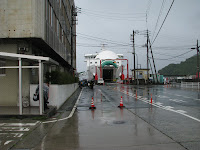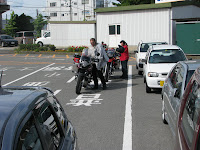 The ferry to Beppu from Shikoku took 3 hours and as you can see from the photos was very relaxing. After arriving, we went north along the coast towards Kunisaki City, a smaller, more rural area, where my friends, Hide and Erica Hosada lived. Erica arranged to meet us at the Oita Airport, south of her home
The ferry to Beppu from Shikoku took 3 hours and as you can see from the photos was very relaxing. After arriving, we went north along the coast towards Kunisaki City, a smaller, more rural area, where my friends, Hide and Erica Hosada lived. Erica arranged to meet us at the Oita Airport, south of her homeA motorcycle trip from Nanaimo, B.C. Canada, to Japan and on through Siberia,Mongolia, The Stans, Russia, Europe and across North America and beyond.
Saturday, May 29, 2010
Kyushu
 The ferry to Beppu from Shikoku took 3 hours and as you can see from the photos was very relaxing. After arriving, we went north along the coast towards Kunisaki City, a smaller, more rural area, where my friends, Hide and Erica Hosada lived. Erica arranged to meet us at the Oita Airport, south of her home
The ferry to Beppu from Shikoku took 3 hours and as you can see from the photos was very relaxing. After arriving, we went north along the coast towards Kunisaki City, a smaller, more rural area, where my friends, Hide and Erica Hosada lived. Erica arranged to meet us at the Oita Airport, south of her homeShikoku

Shikoku is less visited by foreign tourists than other parts of Japan. It is however visited by many Japanese as religious pilgrims. The pilgrimage involves walking the 1400 km. circumference of the island and visiting 88 temples along the way. You will see the pilgrims with their white clothing, hats and walking sticks here and there all around the outer roads of Shikoku.
 Heading down towards the coast from the Iya Valley, asking directions from a farmer and his wife.
Heading down towards the coast from the Iya Valley, asking directions from a farmer and his wife.Shikoku

Ferry arrived in Tokushima on the island of Shikoku after a two hour trip. Japanese ferries have few seating areas. Instead there are upraised carpeted sections where you remove your shoes and are able to lay down and read, rest, or do whatever you wish, very civilized. B.C. ferries could learn a thing or two!
 After staying the night in Tokushime. we headed inland to the Iya Valley, a remote area by Japanese standards. Twisty roads, mountainous and some rain. Like a lot of Japan outside of the urban areas, it is heavily forested.
After staying the night in Tokushime. we headed inland to the Iya Valley, a remote area by Japanese standards. Twisty roads, mountainous and some rain. Like a lot of Japan outside of the urban areas, it is heavily forested.Above, Simon on a curve, Iya Valley.

Near the town of Oboke in the Iya Valley, we stayed at a `Minshuku`, the Japanese equivilent of a B. & B..
It had tatami mats, Japanese furniture and sliding doors.
Futons were layed out for us, shoes left at the front door and slippers provided, as well as sleepwear.
Nara

On the way to Nara to meet up with the others a couple of English ladies pulled up beside me, and we stopped for a chat.
They were, Pat Thomson and Sheonagh Ravensdale, who were motorcycling through Japan after having done Latin America. Their names had been mentioned to me by a Swedish lady biker in Tokyo.Coincidence to run in to them. They are heading to South East Asia next. Their travels are posted on the `Horizons Unlimited` site.
 In Nara with Mr. Kurimya, a very kind man and our volunteer guide for the day. We were all staying at the Nara Youth Hostel.
In Nara with Mr. Kurimya, a very kind man and our volunteer guide for the day. We were all staying at the Nara Youth Hostel. Buddhist monks collecting alms, downtown Nara.
Buddhist monks collecting alms, downtown Nara.
Feeding the deer, Nara
 Todai-ji Temple, largest wooden structure in the world. It was rebuilt after a fire in 1709, and is two thirds size of the original.
Todai-ji Temple, largest wooden structure in the world. It was rebuilt after a fire in 1709, and is two thirds size of the original.
In it, the Great Buddha.

On the back of the base of the Great Buddha is an inscription depicting the end of the Silk Road in Nara.
A new building on the edge of Nara, a copy of the Imperial Audience Hall for meeting foreign dignitaries, installation of the Emperor and other political ceremonies.
Through Nara traffic. We left Nara and headed for the coast and the port city of Wakayama to catch the ferry to Tokoshima on the island of Shikoku.
Friday, May 28, 2010
Zen and the Art of............Kyoto.



 Above, T to B., Shinto shrine, Fan store, Aoi Festival actors.
Above, T to B., Shinto shrine, Fan store, Aoi Festival actors.Kyoto (1.5 million) is Japan`s cultural center with over two thousand temples and shrines, dedicated to Buddhism and Shinto.
The Aoi Festival was on while I was in Kyoto. Aoi refers to the Hollyhock plant, which is believed to have protective qualities against earthquakes and natural disasters. It originated in the 7th century in an effort to appease the Gods and have a bountiful harvest

Originally it involved Ladies from the royal court and its representatives who represented its interests

Court figure.

The train station is new. Fifteen stories high, multiple escalators and shops, and a rooftop garden on top. Very impressive!

Artist at work.

Pretty ladies in kimonos, a common sight in the city.

View of Kyoto from a Buddhist temple on the hillside on the edge of the city

Obligatory photo with a group of school kids. It happens all the time.

Temple, Kyoto.

Buddhist temple entrance. The influence of Zen is everywhere in the religious grounds. Beauty, simplicity, functuality.
Was expecting to meet up with the others in Kyoto when some bad news broke. Mike Casey had had an accident at a stoplight. The good news was that he hadn`t been badly hurt. Cracked ribs and collarbone, but with prompt medical attention with Simon and Cain there. The motorcycle received little damage.

The train station is new. Fifteen stories high, multiple escalators and shops, and a rooftop garden on top. Very impressive!

Artist at work.

Pretty ladies in kimonos, a common sight in the city.

View of Kyoto from a Buddhist temple on the hillside on the edge of the city

Obligatory photo with a group of school kids. It happens all the time.

Temple, Kyoto.

Buddhist temple entrance. The influence of Zen is everywhere in the religious grounds. Beauty, simplicity, functuality.
Was expecting to meet up with the others in Kyoto when some bad news broke. Mike Casey had had an accident at a stoplight. The good news was that he hadn`t been badly hurt. Cracked ribs and collarbone, but with prompt medical attention with Simon and Cain there. The motorcycle received little damage.
The others stayed an extra day with Casey to make sure he was alright and settled, and then continued on to Nara, 30 Kms. outside of Kyoto where we decided to meet up.
Casey will recuperate in Japan, and depending on how he feels, may continue on the trip by bike at a later date.
A-Tokyo, B-Kyoto.
A-Tokyo, B-Kyoto.
Subscribe to:
Posts (Atom)




























